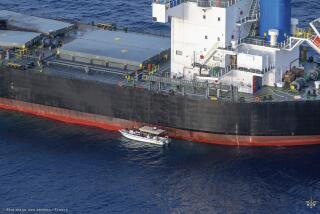U.S. Explorer Locates Phoenician Ships, Cargo
- Share via
TEL AVIV — Phoenician mariners sailed more than 2,500 years ago into the uncertain waters of the Mediterranean, praying to their storm god for a successful voyage--only to meet death in a fierce tempest.
Now, American explorer Robert Ballard has located their two ships--the world’s oldest known deep-water sea wrecks--using the same techniques he used to find the Titanic.
The vessels’ cargo--large ceramic containers of wine--was probably headed for the pharaoh’s table in Egypt or to the Phoenician colony of Carthage in present-day Tunisia, Ballard told a news conference Wednesday, in announcing the discovery.
The ships’ contents indicate that they set sail from the Phoenician port of Tyre--now a city in Lebanon--around 750 B.C. Both vessels were transporting ceramic jugs, called amphorae, filled with wine.
Remarkably, the amphorae were found intact, stacked snugly in rows, unlike the shards typically unearthed on land. Archeologist Lawrence Stager, one of several Harvard University scientists on Ballard’s team, said the discovery of the pristine jugs “was one of our greatest moments.”
The ships were also almost perfectly preserved--a result of the bitterly cold deep-sea waters, where sunlight cannot reach, the pressure is intense and sediment scarcely accumulates.
Ballard said the ocean’s deepest waters are capable of suspending history in time. “Human history lost in the high seas is waiting to be discovered,” said Ballard, who was propelled to fame by his 1985 discovery of the ocean liner Titanic.
Ballard, a former naval officer and oceanographer, uncovered the Phoenician vessels about 30 miles off Israel with the aid of an underwater robot, deep-water tracking equipment and a global positioning satellite. He was led to the area after a team looking for the Dakar, an Israeli submarine that sank 35 years ago, photographed what appeared to be the remains of an ancient shipwreck.
The vessels were discovered sitting upright on the ocean floor at a depth of about 1,500 feet. The fact that they sank straight to the bottom and were located within two miles of each other indicated that they sank in a storm, Ballard said.
One ship is about 60 feet long and the other measures 45 feet. The vessels were probably part of a fleet of cargo ships on consignment, Stager said. Stone anchors were found, as well as crockery, a wine decanter and incense stands for offering prayers to the weather gods.
Ballard said the two vessels were the first intact Phoenician ships ever found and will aid historians and archeologists, who until now had to rely on classical texts and the Bible for an idea about Phoenician shipping. Phoenicians were a seafaring people who lived along the Levantine coast.
More to Read
Sign up for Essential California
The most important California stories and recommendations in your inbox every morning.
You may occasionally receive promotional content from the Los Angeles Times.













